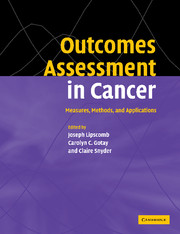Book contents
- Frontmatter
- Contents
- List of contributors
- Acknowledgments
- 1 Introduction to Outcomes Assessment in Cancer
- Health-related quality of life in cancer: general concepts and generic measures
- Assessing health-related quality of life during treatment
- Assessing health-related quality of life across the cancer continuum
- Measuring the experience and needs of cancer patients and caregivers
- Methodological considerations in applications to cancer outcomes research
- 17 Practical considerations in outcomes assessment for clinical trials
- 18 Statistical issues in the application of cancer outcome measures
- 19 The clinical value and meaning of health-related quality-of-life outcomes in oncology
- 20 Cross-cultural use of health-related quality of life assessments in clinical oncology
- Modern psychometric theory in cancer outcomes research
- Assessing the economic impact of cancer
- Research and policy implications
- Invited papers
- Index
- References
19 - The clinical value and meaning of health-related quality-of-life outcomes in oncology
Published online by Cambridge University Press: 18 December 2009
- Frontmatter
- Contents
- List of contributors
- Acknowledgments
- 1 Introduction to Outcomes Assessment in Cancer
- Health-related quality of life in cancer: general concepts and generic measures
- Assessing health-related quality of life during treatment
- Assessing health-related quality of life across the cancer continuum
- Measuring the experience and needs of cancer patients and caregivers
- Methodological considerations in applications to cancer outcomes research
- 17 Practical considerations in outcomes assessment for clinical trials
- 18 Statistical issues in the application of cancer outcome measures
- 19 The clinical value and meaning of health-related quality-of-life outcomes in oncology
- 20 Cross-cultural use of health-related quality of life assessments in clinical oncology
- Modern psychometric theory in cancer outcomes research
- Assessing the economic impact of cancer
- Research and policy implications
- Invited papers
- Index
- References
Summary
The clinical value of measuring health-related quality of life
Common clinical outcomes
Before the modern era of objectivity in clinical oncology research, reports of the effects of therapy were often based on an individual clinician's experience (case reports and series). As awareness of the advantages of research objectivity increased, several clinical outcomes, including overall survival, median survival time, tumor-free survival, progression-free survival, time to progression, and frequency and duration of tumor response, were accepted and widely used. Of these, overall survival is considered as being the “hardest” endpoint, i.e., least likely to be subject to misinterpretation, and tumor response the “softest” endpoint.,
In addition, the concept of levels of evidence was introduced.– The highest level of evidence, Level I, consists of data from meta-analysis of several phase III randomized controlled clinical trials (RCTs) or a very large, phase III trial containing several hundred patients. The lowest level of evidence, Level IV, is data derived from small, uncontrolled case series or reports. Currently, institutions collaborate with each other to enroll the large number of patients needed to produce Level I evidence, and eligibility criteria for patient enrollment are increasingly stringent in order to control as many clinical variables as possible.
The interpretation of clinical trials has been aided by the collection of toxicity data. As with response and survival data, there has been an attempt to become more comprehensive by collecting very detailed information with uniform grading systems.
- Type
- Chapter
- Information
- Outcomes Assessment in CancerMeasures, Methods and Applications, pp. 386 - 405Publisher: Cambridge University PressPrint publication year: 2004
References
- 6
- Cited by



